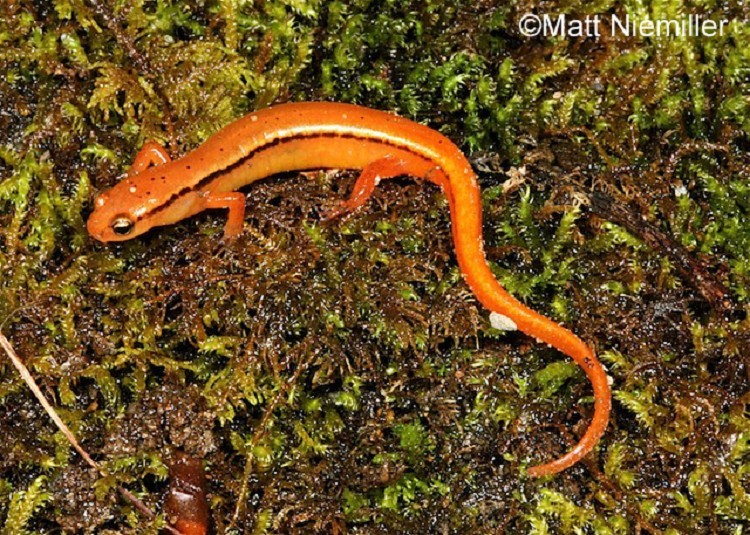Blue Ridge Two-lined Salamander
Eurycea wilderaeOne of two species of the Eurycea bislineata complex, the Blue Ridge Two-lined Salamander occurs in the Blue Ridge Mountains. Southern Two-lined Salamander extends from the bottomland habitats in West Tennessee to the upland foothills of the Blue Ridge Mountains.
Description: A small, slender salamander (2.5 to 4.0 inches in length) having yellowish, or sometimes greenish or orangish, dorsum with two broad, black lines extending from the eye along the top of either side to the middle of the tail where line breaks into dots. Many individuals also have black spots along the back between the two lines. The belly is whitish to yellow.
Similar Species: Separated by Southern Two-lined Salamander by range and markings (more yellow to brownish and has solid black lines along the top of either side of back).
Junaluska Salamander resembles both two-lined salamanders, but has no distinct black stripes on the sides and has a shorter tail.
Habitat: Found in moist habitats of Blue Ridge Mountains. Commonly found beneath rocks, leaves, and logs along the edges of woodland streams and seeps, but some may occur on the forest floor.
Diet: Variety of terrestrial invertebrates.
Breeding information: Adults migrate to breeding streams in late winter to early spring. Between 8-56 eggs are attached under rocks in streams; sometimes under logs, sticks, or leaves. Female attends the eggs until they hatch in spring. The larval period lasts from 1-2 years.
Status in Tennessee: Abundant throughout their range and one of the most abundant salamanders in Great Smoky Mountain National Park. Potential risks include habitat destruction through activities such as clearcutting and acid mine drainage.
Fun Facts:
- Blue Ridge Two-lined Salamanders below 4000 ft elevation have 14 Coastal Grooves, whereas those above 4000 ft have 15 or 16. Costal grooves are furrows on the sides of salamanders involved in the attachment of body wall muscles for the ribs and vertebrae. Costal grooves are helpful in salamander identification.
Best places to see in Tennessee: All elevations of Great Smoky Mountains National Park.
